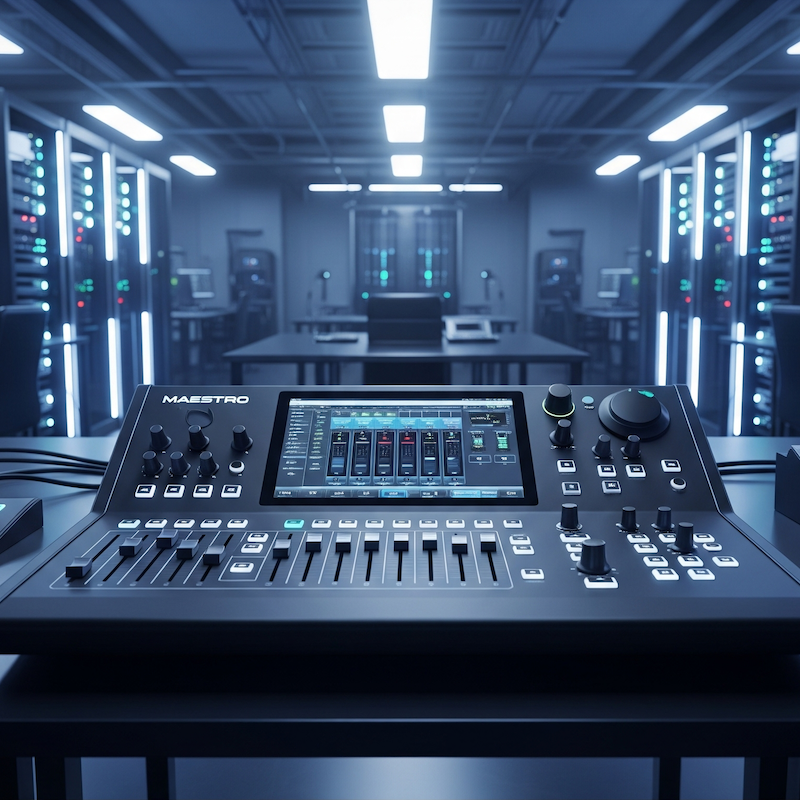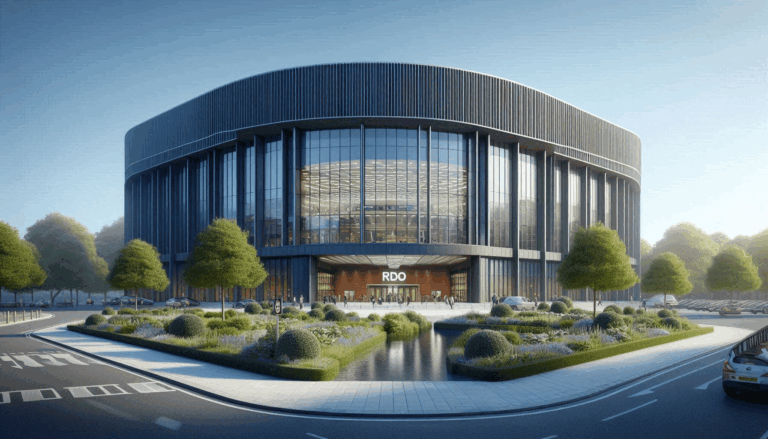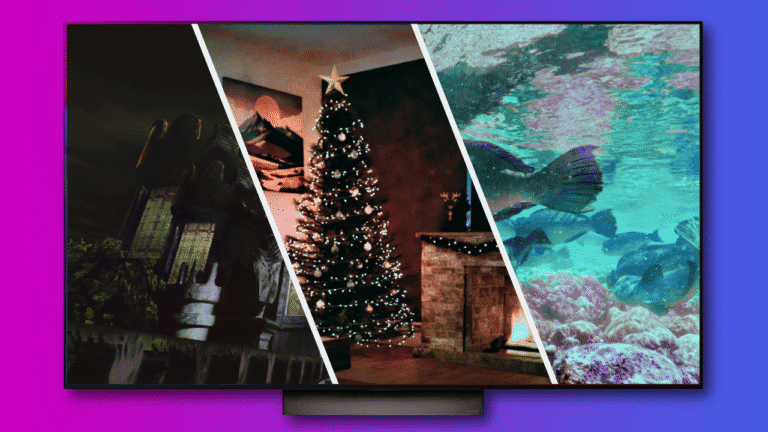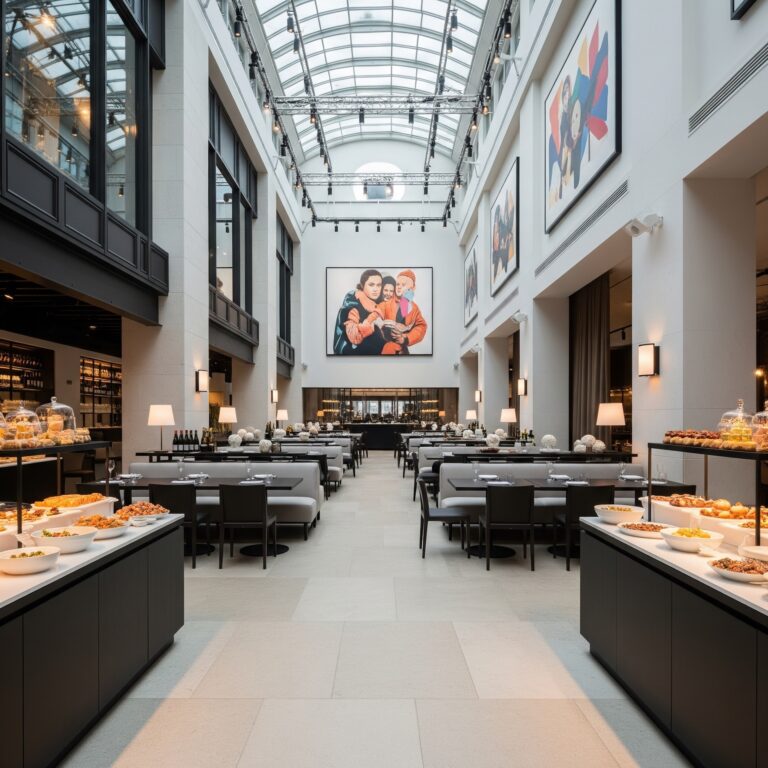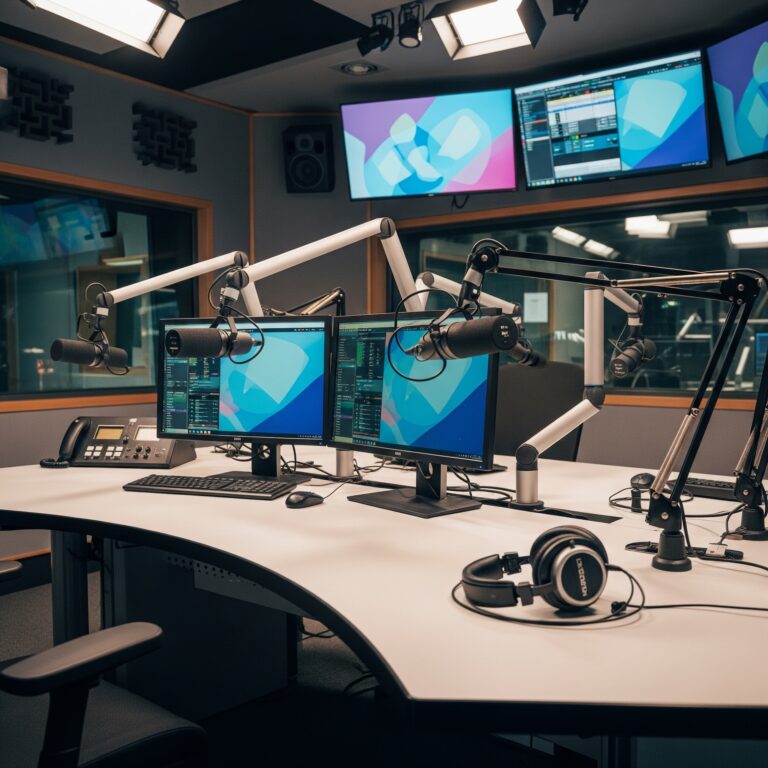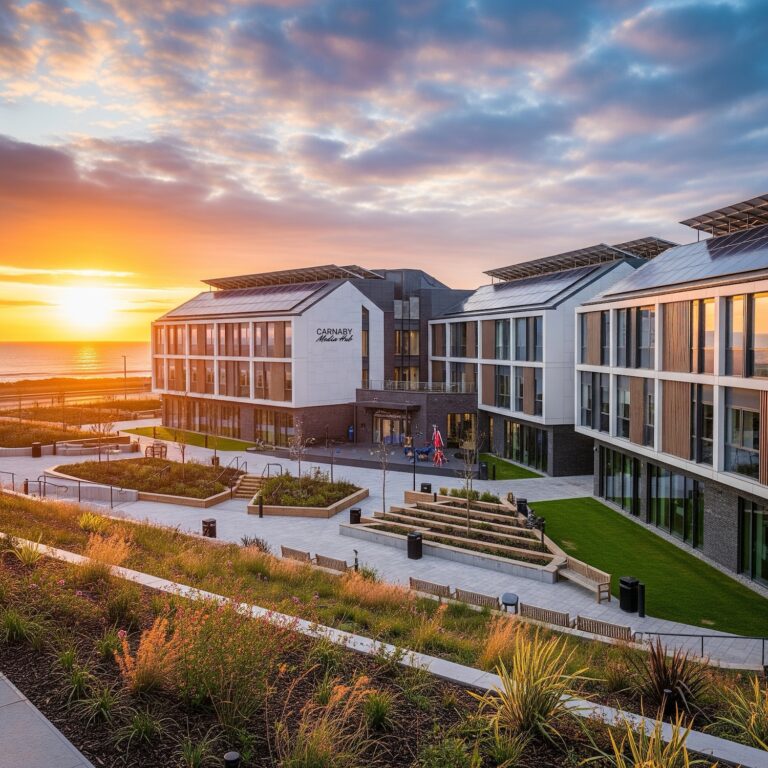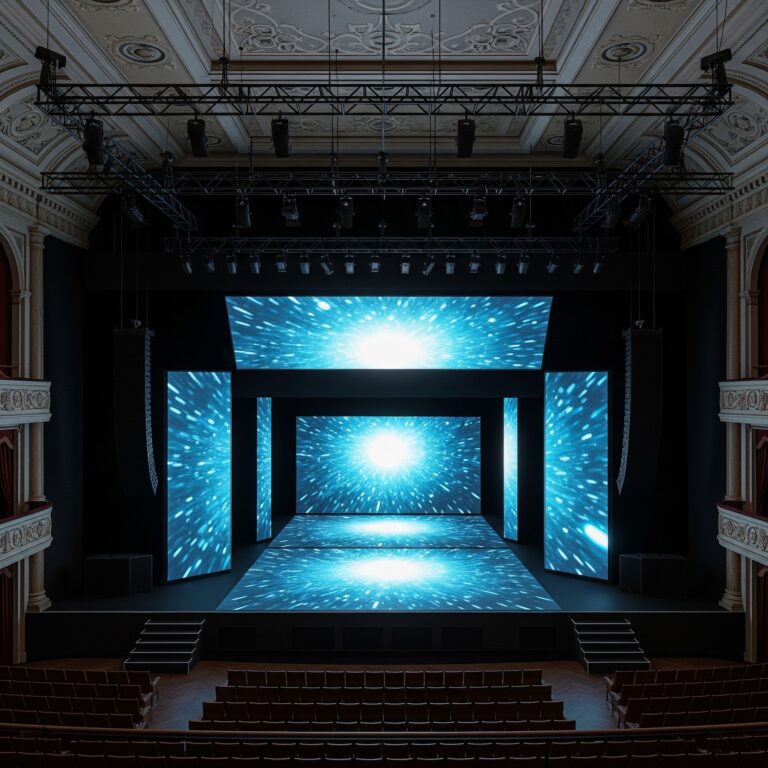R&D: Pioneering the Future of Media Production at CMH
In the ever-accelerating universe of media production, where technology evolves faster than a Hollywood blockbuster’s special effects, standing still will mean becoming a dinosaur in a tutu. At the Carnaby Media Hub, our very design is predicated on avoiding extinction. That’s why, conceptualized to be nestled within our state-of-the-art campus, a dedicated Research and Development (R&D) division will beat as the very heart of innovation – a team of forward-thinking specialists whose mission will be nothing less than to future-proof the entire industry, one ingenious idea at a time.
This R&D powerhouse at CMH isn’t merely envisioned for gazing into crystal balls and predicting the next big thing (though, admittedly, they will have a pretty impressive collection of theoretical lab coats). Their mandate is refreshingly practical: they are designed to be the engine room that keeps CMH itself running at peak efficiency, constantly discovering smarter, faster, and more creative ways to connect the dots across our complex ecosystem. Think of them as the ultimate problem-solvers, armed with code, circuits, and a healthy dose of “what if?” – all in pursuit of making the impossible, effortlessly achievable.
However, that’s only half the story. While CMH’s R&D team will be laser-focused on optimizing our internal processes – from streamlining workflows to developing custom software solutions tailored to our unique needs – their ambitions are set to extend far beyond our own walls. They will be driven by a vision of shared progress, a belief that innovation shouldn’t be hoarded but rather cultivated, refined, and elevated for the benefit of the entire media landscape. This means taking successful internal experiments and transforming them into proposed industry standards, and even developing cutting-edge products that could revolutionize how media is made globally.
Consider, for instance, a theoretical R&D project that would arise from a specific anticipated CMH need: a compact, all-in-one hardware console designed for single-operator efficiency. Imagine a device that seamlessly integrates lighting, audio, and video control – powerful enough to handle complex tasks, yet intuitive enough for a single technician to master. This “Maestro Mini-Console,” as we might call it, would be a perfect illustration of CMH’s R&D philosophy in action: solving an internal challenge, then realizing its potential to transform how everyone in the industry could work.
Over the course of this post, we’ll delve into the inner workings of CMH’s proposed R&D division, exploring their dual mission, their innovative spirit, and the tangible impact they are designed to have on both our own operations and the broader media industry. We’ll follow the theoretical journey of the “Maestro Mini-Console” from its initial concept to its potential as a market disruptor, showcasing how CMH isn’t just planning to adapt to the future of media production – we’re laying the groundwork to actively build it.
The Internal Compass: Optimising CMH’s Ecosystem
While the Carnaby Media Hub is envisioned as a nexus of creativity and production prowess, even the most cutting-edge blueprint requires a dedicated force to ensure its gears turn with unparalleled efficiency. This is the primary, internal mission of CMH’s R&D division: to act as the campus’s very own internal compass, constantly pointing towards greater optimisation, seamless integration, and smarter ways of working. They’re the unsung heroes who ensure that our state-of-the-art facilities don’t just look good on paper but operate like a perfectly choreographed symphony, where every department moves in effortless harmony. Their work isn’t about grand, external gestures at this stage, but about the intricate, often invisible, enhancements that make every single process across the Hub smoother, faster, and more effective.
A significant portion of this internal optimisation will manifest through bespoke software development. While off-the-shelf solutions serve a purpose, CMH’s R&D team will be tasked with identifying unique bottlenecks and crafting custom digital tools that are precisely tailored to our workflow. Imagine, for instance, a project’s vast array of digital assets – from 3D scans and raw footage to soundscapes and visual effects layers – constantly moving between departments. R&D would develop sophisticated workflow automation scripts and applications that intelligently manage this flow, automatically transcoding files to optimal formats as they pass from editing to VFX, or notifying teams instantly when an asset update is ready for review. This isn’t just about saving clicks; it’s about eliminating manual hand-offs that are prone to human error and delay, ensuring a continuous, unbroken creative chain. They might build an AI-powered assistant for automated rotoscoping, dramatically reducing the painstaking manual work of isolating foreground elements in footage. This isn’t about replacing artists, but about freeing them from tedious, repetitive tasks so they can focus their formidable talents on the truly creative challenges. Or consider the intricate process of sound mixing: R&D could develop intelligent sound mixing assistance software that learns from previous projects, suggesting initial mixes, identifying potential audio clashes, or even automatically adjusting levels based on dialogue detection, providing a robust starting point for our expert sound engineers. Furthermore, continuous enhancements to our overarching asset management system would fall squarely within R&D’s purview, ensuring that every digital file, no matter its origin or destination, is instantly discoverable, securely stored, and readily accessible to authorised personnel across the sprawling campus. It’s like building the ultimate digital librarian who not only knows where everything is but can anticipate what you’ll need next.
Beyond the realm of pure code, the R&D team will be instrumental in technique innovation, developing new methodologies that push the boundaries of media production within CMH’s walls. Take virtual production, for example – a field still evolving at warp speed. R&D would experiment with novel approaches to LED volume calibration, developing proprietary methods for seamless foreground-background integration or advanced real-time colour grading that optimises the visual fidelity directly on the set. For motion capture, they might devise new ways to capture nuanced finger movements more accurately using passive markers, or integrate AI-driven skeletal tracking that reduces the need for extensive post-capture clean-up. When it comes to lighting setups, R&D could explore adaptive lighting systems that automatically adjust intensity and colour temperature based on changing environmental conditions or camera settings, providing cinematographers with unprecedented control and efficiency. Even something as fundamental as data handling stands to benefit; R&D would pioneer hyper-efficient data compression algorithms tailored for high-resolution media files, or devise advanced parallel processing techniques to slash render times, ensuring that even the most demanding projects flow smoothly. And, crucially, their work would extend to green practices, developing new methods for energy efficiency within our studios, discovering ways to recycle and reuse set materials, or pioneering fabrication techniques that minimise waste from concept to completion. They would be the environmental champions, constantly seeking to reconcile cutting-edge production with ecological responsibility.
Hardware, too, will fall under R&D’s watchful eye, ensuring our physical tools are as sharp as our digital ones. This includes custom modifications to existing gear, where an off-the-shelf camera rig might be adapted for a specific CMH need, or a standard lighting fixture re-engineered for enhanced performance or reduced power consumption. They would focus on integration solutions for disparate systems, building the metaphorical bridges (and literal cables) that allow different manufacturers’ equipment to communicate seamlessly, eradicating compatibility headaches that often plague complex studios. Consider the logistical challenge of moving massive data sets: R&D might develop proprietary high-speed transfer hardware or custom wireless links that allow instant data offload from cameras to central storage, cutting down on physical media handling and improving on-set efficiency. Ergonomic improvementswould also be a key focus; whether it’s designing more comfortable control interfaces for long production days or creating custom mounting solutions that reduce technician fatigue, R&D would ensure the human operators are as comfortable and efficient as possible. Their role in internal tool development is where our “Maestro Mini-Console” concept truly takes root.
Let’s illustrate this with the very genesis of our Maestro Mini-Console. CMH frequently manages multiple smaller, concurrent productions, alongside specialized department demos, individual actor coaching sessions, or even quick tech scouts for upcoming projects. Each of these scenarios often requires some combination of basic lighting adjustments, audio playback, or simple video switching – but without the need for a full, multi-person control room setup. The internal bottleneck was clear: either you pulled skilled technicians away from larger productions for minor tasks, or you made do with clumsy, piecemeal setups involving laptops and multiple dongles, wasting precious time in deployment and configuration. R&D would identify this precise need. They would observe technicians struggling with disparate interfaces, see the minutes ticking away during setup, and recognise the inherent inefficiency. Their solution: a compact, integrated console that could be wheeled into any space – a rehearsal room, a motion capture volume, a green screen corner – and be fully operational within minutes, managed by a single individual. It would address the need for rapid deployment and cross-departmental simplicity, allowing a single technician or even non-specialist staff (like an actor’s movement coach or a costume designer needing specific light for a fitting) to manage basic technical elements without calling in a full tech team. This internal project, born from a practical, everyday frustration within CMH, would become the first iteration of the Maestro Mini-Console, a beacon of R&D’s dedication to making CMH’s ecosystem run like a perfectly oiled, future-proof machine.
The work of CMH’s R&D in optimising the internal ecosystem is a continuous, evolving process. They are the proactive guardians of efficiency, constantly seeking out opportunities for improvement, leveraging cutting-edge technology not just for its own sake, but to streamline every operation, amplify every creative effort, and ultimately, ensure that Carnaby Media Hub truly is the most efficient and innovative media production campus on the planet. Their internal compass points directly to unparalleled operational excellence.
Bringing it to Life: Software, Hardware, and Seamless Integration
With the concept of the Maestro Mini-Console meticulously laid out – a vision born from the anticipated needs of a busy, future-forward campus like CMH – the R&D team faced the exhilarating challenge of translating that blueprint into a tangible, functional reality. This wasn’t a linear process of software first, then hardware; rather, it was a finely synchronized dance, a continuous interplay between digital design and physical engineering, all aimed at achieving an unprecedented level of seamless integration. Imagine a composer writing a symphony while the orchestra is simultaneously being built around them; that’s the kind of complex, iterative creation that defines this stage of R&D.
The software buildout was, in many ways, the very soul of the Maestro Mini-Console. While the physical console would be its body, the custom operating system and intuitive graphical user interface (GUI) would provide its intelligence and personality. The R&D software engineers, a brilliant collective of coders who likely dream in lines of C++ and Python, began by designing a bespoke, lightweight OS tailored specifically for real-time media control. This wasn’t about running complex desktop applications; it was about lightning-fast responsiveness, rock-solid stability, and the ability to process multiple data streams simultaneously without a hiccup. The core logic for managing the diverse protocols – DMX and ArtNet for lighting, Dante for networked audio, and SDI/HDMI for video – required deep dives into their respective intricacies, ensuring perfect handshakes and zero latency. For example, the software would need to translate an ArtNet lighting command into precise DMX output in milliseconds, while simultaneously routing a Dante audio stream and switching a 12G SDI video input, all without causing a digital stutter. This level of cross-protocol mastery is far from trivial; it’s where true engineering artistry comes into play, turning what might be a jumble of incompatible signals into a harmonious flow.
The GUI, designed with the single operator firmly in mind, would be built from the ground up to be not just visually appealing, but profoundly intuitive. Think less “deep dive into endless menus” and more “instant access to what you need, when you need it.” The R&D’s UX (User Experience) specialists, almost like mind-readers, would meticulously map out the operator’s likely thought process, ensuring that assigning functions to the 16 physical faders or their 3 accompanying pots, for example, was a drag-and-drop affair on the touchscreen, not a convoluted navigation exercise. They might even incorporate basic AI features for automation; imagine the console intelligently suggesting a basic lighting auto-patch based on connected fixtures, or offering subtle audio level assistance to prevent unexpected peaks. These aren’t AI overlords; they’re clever digital assistants designed to offload tedious setup tasks, freeing the operator to focus on the creative nuances of the show.
Concurrently, the hardware prototyping team, the console’s physical architects, would be busy sculpting its tangible form. Their challenge was formidable: to encapsulate all this powerful functionality into a compact, robust, standalone unit that could withstand the rigours of constant transport and diverse production environments. Selecting the right components was paramount: a high-resolution, multi-touch display durable enough to handle continuous use; smooth, responsive faders and rotary pots that offer precise control without feeling flimsy; and industrial-grade I/O ports capable of withstanding countless connections and disconnections. The physical design would extend to critical considerations like thermal management, ensuring the internal processors remain cool even during intense, prolonged operation, preventing performance degradation. Then there was the constant push for ergonomic design for a single operator. Every button placement, every angle of the integrated touchscreen, every physical dimension would be scrutinised to ensure maximum comfort and minimal strain during long setup times or demanding rehearsals. It’s about crafting a tool that feels like a natural extension of the operator’s hands and mind, not a cumbersome piece of machinery.
The real magic, however, lies in the integration challenge. This is where the separate threads of software and hardware development truly intertwine. R&D’s systems integration specialists, the ultimate unifiers, would be responsible for making disparate industry protocols – DMX from the lighting world, Dante from the audio realm, and SDI/HDMI from video – communicate flawlessly within one cohesive unit. This might involve developing custom communication drivers, optimising data pipelines to minimise latency between control input and system output, and creating robust internal network architectures to ensure that a command to fade a light doesn’t cause an audio dropout. The complexities are immense; ensuring a touch on the screen to switch a camera is instantly reflected by the video output, while simultaneously triggering a lighting cue and an audio sample, all through different underlying protocols, requires masterful engineering. They’d face challenges like preventing electrical interference between various signal types crammed into a small chassis, or ensuring consistent timing across all controlled elements. It’s a bit like building a miniature, perfectly synchronised orchestra within a shoebox, where every instrument plays its part without missing a beat.
Guiding this intricate dance of creation would be the R&D team members themselves, true architects of tomorrow’s production tools. Lead software engineers, with their encyclopaedic knowledge of coding languages and network protocols, would craft the console’s digital brain. Embedded systems specialists would bridge the gap between software and hardware, ensuring components communicate perfectly. Industrial designers, with an eye for both aesthetics and ergonomics, would sculpt its physical form. Together, they embody the collaborative spirit of CMH R&D – a multidisciplinary fusion where problem-solving meets pioneering spirit, all dedicated to transforming complex challenges into elegant, efficient solutions.
The Crucible of Reality: Testing, Refinement, and Iteration
With the Maestro Mini-Console’s software humming and its hardware gleaming, the R&D team’s excitement would be palpable. But for every visionary engineer, there’s a pragmatist waiting to throw a wrench in the gears – metaphorically, of course. This is where the truly gritty work begins: the relentless, often humbling, process of testing, refinement, and iteration. It’s the crucible of reality, where brilliant theories meet the chaotic demands of a live production environment, and where the Maestro Mini-Console would truly earn its stripes within the Carnaby Media Hub. No matter how perfectly designed a system looks on paper, the real world always has a few surprises up its sleeve.
The initial phase of this rigorous scrutiny would involve internal deployment and a comprehensive feedback loopright within CMH’s planned facilities. Early prototypes of the Maestro wouldn’t just sit on a lab bench; they’d be strategically introduced into various operational settings across the campus. Imagine a unit deployed in a rehearsal room, managing the lighting cues and audio playback for an actor’s coaching session. Another might find its way into a small green screen studio, handling camera switching and basic keying for a quick previz shot. Yet another could be on a tech prep bay, allowing technicians to patch and test lighting fixtures or audio lines with unparalleled efficiency. This isn’t just about functionality; it’s about real-world usability. The R&D team would actively solicit crucial feedbackfrom CMH’s own staff – the seasoned lighting technicians who live and breathe DMX, the audio engineers who can spot a latency issue before it even registers, the stage managers juggling a dozen tasks, and even the directors who simply need a seamless tool to realise their vision. Their practical insights, often delivered with a bluntness born of experience, would be invaluable, highlighting friction points that no theoretical simulation could ever uncover. “It works, but why is this button here?!” or “Can it please do this specific thing I do 50 times a day?” would become mantras for improvement.
This invaluable user feedback would fuel continuous bug fixing and performance optimisation. The R&D team would enter an intense, iterative cycle: identifying reported issues, meticulously diagnosing their root causes, refining the console’s code, and tweaking its hardware. Perhaps an early prototype shows a fractional delay when switching between certain video inputs, or a particular combination of DMX fixtures causes an unexpected hang. These aren’t failures; they’re opportunities. Each bug would be a puzzle to solve, each performance bottleneck a challenge to overcome. This could involve optimising core algorithms to slash processing times, rewriting segments of the operating system for greater stability, or even making minor hardware revisions to improve heat dissipation or port durability. This commitment to relentless iteration ensures that the Maestro Mini-Console wouldn’t just be functional, but robust, reliable, and incredibly fast – qualities essential for the high-pressure world of media production. It’s a bit like taking a supercar prototype to the Nürburgring; you keep pushing it until every component screams perfection.
A central tenet of this phase would be a relentless focus on usability and workflow integration. For a console designed for a single operator, intuitiveness isn’t a luxury; it’s a necessity. R&D’s user experience (UX) designers would refine the touchscreen interface, ensuring navigation is fluid, controls are logically grouped, and visual feedback is immediate and clear. They’d painstakingly ensure that the customizability offered by the 16 faders and their assignable pots genuinely empowers the user, rather than overwhelming them. This iterative refinement, directly informed by practical application within CMH, would lead to profound technique innovation. The Maestro Mini-Console, once adopted internally, wouldn’t just fit into existing workflows; it would actively change them. Suddenly, a stage manager could quickly dial in rehearsal lighting without waiting for a dedicated lighting technician. An audio engineer could set up a small ADR session with unparalleled speed. Directors could conduct technical blocking runs in a fraction of the time, seamlessly controlling lighting states, audio cues, and camera angles from a single point. This would lead to the development of entirely new best practices within CMH, showcasing how a well-designed tool can fundamentally redefine efficiency and creative possibilities. It transforms what was once a multi-step, multi-person process into an elegant, single-operator dance.
Throughout this demanding phase, the dedication of the R&D team members would shine through. The QA engineers, with their eagle eyes for imperfections, would systematically try to break the console, pushing its limits to uncover every conceivable flaw. The UX designers would be the champions of the user, tirelessly advocating for simplicity and intuitiveness. And the project managers overseeing these deployments would orchestrate the intricate dance of feedback collection, bug reporting, and feature implementation. Their collaborative spirit, coupled with an unwavering commitment to excellence, ensures that the Maestro Mini-Console isn’t just a powerful piece of technology; it’s a finely tuned instrument, forged in the crucible of real-world testing, ready to empower a new generation of single-operator productions. It becomes a testament to CMH’s internal commitment to operational excellence.
Beyond Internal Use: Setting Standards & Eyeing the Market
The Maestro Mini-Console, having successfully navigated the crucible of internal development and rigorous testing within CMH’s theoretical walls, would quickly prove its worth. Technicians would praise its intuitiveness, efficiency would soar in various small-scale operations, and the sheer elegance of having a single, portable unit for multifaceted control would become undeniably clear. It’s often said that true innovation happens when a solution for a specific problem turns out to be precisely what everyone else needed all along, they just hadn’t articulated it yet. This is precisely the trajectory the Maestro Mini-Console would begin to chart, moving from an internal champion to a potential industry game-changer.
The first hint of this broader impact would emerge from the identification of a wider industry need. As CMH’s R&D team celebrated their internal success, their antennae would tune into the broader market. They’d realise that the challenges faced within CMH – the need for a versatile, single-operator control solution for quick setups, rehearsals, educational environments, small independent productions, corporate AV events, and even houses of worship – were not unique to our campus. Independent filmmakers struggle with lean crews and complex technical demands. Small theatre groups often operate on shoestring budgets with volunteer technical staff. Educational institutions need robust, yet easy-to-learn, equipment for student training. All these sectors yearn for powerful tools that don’t require an army of specialised technicians or a full control room. The Maestro Mini-Console, forged in the fires of CMH’s internal efficiency drive, would emerge as an almost perfect fit, offering professional-grade control in an accessible, highly portable package. It’s the kind of solution that makes you slap your forehead and exclaim, “Why didn’t anyone think of this before?!” (and the answer, of course, is that R&D did).
As the Maestro Mini-Console’s capabilities became evident, particularly its seamless integration of disparate protocols like DMX/ArtNet for lighting, Dante for audio, and SDI/HDMI for video, CMH’s R&D would recognise an opportunity to contribute to, and even shape, new industry protocols and standards. Imagine a scenario where the Maestro’s custom internal logic for synchronising lighting cues with audio triggers across network boundaries proves exceptionally robust and efficient. Or perhaps its innovative approach to user-assignable control surfaces presents a novel paradigm for how operators interact with complex systems. Instead of keeping this proprietary, CMH’s R&D would actively engage with leading industry bodies such as ESTA (Entertainment Services and Technology Association) for lighting control standards, AES (Audio Engineering Society) for audio protocols, or SMPTE (Society of Motion Picture and Television Engineers) for video standards. CMH would champion the adoption of these new solutions as open standards, sharing the underlying principles or even contributing code to open-source initiatives. This isn’t just altruism; it’s strategic. By contributing to open standards, CMH would foster interoperability, encourage widespread adoption, and cement its reputation as a thought leader committed to advancing the entire media ecosystem, ensuring a rising tide lifts all boats. It’s a bold move, but one that aligns perfectly with CMH’s vision of being a catalyst for progress, not just a consumer of technology.
This commitment to external impact naturally leads to the exciting prospect of commercial product development and a clear Return on Investment (ROI). The Maestro Mini-Console, having demonstrated its formidable capabilities within CMH, would present a compelling case for marketisation. The investment in its R&D – an investment initially made to solve internal efficiency challenges – would now begin to yield direct financial returns through external sales. This transition from internal tool to marketable product involves a series of calculated steps: meticulous market analysis to identify precise niches and pricing strategies; engaging with potential manufacturing partners who possess the scale and expertise to produce the console at volume; and developing a robust branding and marketing strategy to position the Maestro as the indispensable control solution for its target demographic. CMH might consider various business models – perhaps a direct-to-consumer approach for smaller outfits, or licensing the technology to established pro-AV manufacturers for broader distribution. Every unit sold would represent not just a profit, but also a vindication of CMH’s R&D philosophy, demonstrating that investing in solving complex internal problems can create highly desirable, profitable solutions for the wider world. It’s the ultimate win-win: making CMH run better and making the industry better, all while generating revenue that can be reinvested into further cutting-edge research.
Driving this outward-facing strategy would be the dedicated industry liaisons and visionary leaders within CMH’s R&D. These aren’t just technical wizards; they are bridge-builders, adept at navigating both the intricate world of engineering and the dynamic landscape of market demands. Their role would involve attending industry conferences, presenting white papers, engaging with potential partners, and continually assessing the evolving needs of the media production community. They would be the champions of the Maestro Mini-Console’s journey from CMH’s internal labs to studios and venues around the globe, ensuring its features and benefits are clearly communicated and its impact widely felt. Their vision extends beyond this single product, however, always scouting for the next internal innovation that could become the next industry standard or the next groundbreaking commercial offering from CMH.
Future Horizons: Long-Term Vision and Broader Impact
Having witnessed the Maestro Mini-Console’s journey from a gleam in R&D’s eye to a potential industry standard, one might be tempted to think that’s the grand finale. But for CMH’s Research and Development division, the Maestro, brilliant as it may be, is merely a single, albeit highly illustrative, note in a much larger symphony. Their true purpose extends far beyond individual products, however groundbreaking they are. R&D’s most profound impact lies in its relentless pursuit of the next paradigm shift, its unwavering commitment to positioning CMH as a global thought leader, consistently pushing the boundaries of media production technology and methodology, not just for the benefit of our future campus, but for the entire creative world.
This long-term vision positions CMH’s R&D at the vanguard of emerging technologies, peering around corners to anticipate the challenges and opportunities of tomorrow. Imagine the very fabric of computing being revolutionised by quantum computing. While still in nascent stages, R&D would be actively researching its potential implications for rendering complex visual effects or performing lightning-fast simulations that are currently impossible even for supercomputers. This isn’t about immediate application but about understanding the fundamental shifts that could transform entire post-production pipelines. Or consider the evolving landscape of advanced AI in content generation. Beyond merely assisting with rotoscoping or audio mixing, R&D would be exploring how generative AI could realistically create synthetic environments, populate crowd scenes with believable digital extras, or even assist scriptwriters in exploring narrative arcs and dialogue permutations. This isn’t about replacing human creativity, but about augmenting it, providing unparalleled tools for rapid prototyping and boundless creative exploration, ultimately democratizing access to high-quality production capabilities. Imagine artists directing AI to paint entire fantastical landscapes or compose orchestral scores based on a mood prompt – the possibilities are truly mind-boggling.
Furthermore, CMH’s R&D would be at the forefront of the true volumetric capture revolution, moving beyond flat screens and even 360-degree video to create utterly immersive experiences. They’d be researching cutting-edge sensor arrays, advanced photogrammetry techniques, and real-time rendering pipelines capable of capturing and displaying actors, objects, and environments as true 3D holograms that viewers could walk around and interact with in virtual and augmented realities. This isn’t just for film; it opens doors to entirely new forms of storytelling, interactive live performances, and educational experiences where the audience isn’t just watching, but truly present. Their work would aim to overcome current challenges like massive data processing, real-time streaming of volumetric data, and efficient storage, ultimately making “six degrees of freedom” a commonplace reality for media consumption.
Beyond the digital frontier, R&D’s long-term vision extends to the very physical world of production, particularly in areas like sustainable practices and energy innovation. As the industry grapples with its environmental footprint, CMH’s R&D would lead the charge in discovering and implementing new sustainable production materials for sets, props, and even costumes. This could involve pioneering the use of biodegradable polymers that decompose harmlessly after use, mycelium-based composites that “grow” into intricate set pieces, or advanced recycling techniques that allow virtually every element of a temporary structure to be re-purposed. They would work with material scientists to develop paints that sequester carbon, or fabrics derived from renewable plant sources that mimic traditional textiles with even greater durability. It’s about ensuring that the dazzling illusions created on screen don’t come at the cost of our planet.
And speaking of the planet, R&D would also explore groundbreaking energy harvesting technologies applicable within studio environments. Imagine floors that generate electricity from the footsteps of the crew, lighting grids that incorporate micro-solar panels to offset their own consumption, or even innovative HVAC systems that recapture waste heat to power other functions. While currently theoretical for large-scale application, R&D would diligently research and prototype these concepts, striving for a future where CMH could significantly reduce its reliance on external power grids, achieving a truly green production footprint. This holistic approach – from the smallest digital detail to the grandest energy consumption – underscores CMH’s commitment to a sustainable, responsible future for media.
Ultimately, this broad, forward-looking mandate positions CMH not just as a hub of production, but as a catalyst for industry evolution. It’s where bold ideas are given the space to flourish, where the intersection of creative vision and scientific rigor gives birth to what was once unimaginable. CMH’s R&D isn’t simply predicting the future of media; it’s actively investing in, researching, and developing the foundational technologies and methodologies that will shape it. It’s a blend of commercial acumen, ensuring that innovations have tangible value and a return on the significant investment required, and a broader, almost philosophical, vision for pushing the boundaries of human storytelling and technological capability. From the intimate control of a single Maestro Mini-Console to the sweeping impact of quantum-powered rendering or fully sustainable studio practices, CMH’s R&D is dedicated to ensuring that tomorrow’s media is built, quite literally, today.
CMH – Building Tomorrow, Today
We’ve journeyed through the meticulously crafted blueprint of the Carnaby Media Hub, from the foundational ambition of its R&D division to the intricate birth of a pioneering tool like the Maestro Mini-Console. What began as a theoretical response to the relentless pace of technological evolution in media has emerged as a comprehensive vision for a future where innovation isn’t a reaction, but an intrinsic part of the very fabric of production. CMH isn’t merely planning to adapt to the future; it’s meticulously designing the tools and techniques that will shape it.
The dual mission of CMH’s R&D division is a powerful testament to its foresight. Internally, it acts as the tireless engine of optimisation, ensuring that every workflow, every digital asset, and every piece of hardware on the campus functions with peak efficiency. Whether it’s crafting bespoke software for intelligent automation, refining techniques for seamless virtual production, or customising physical equipment for unparalleled ergonomics, R&D’s relentless pursuit of operational excellence ensures that CMH itself operates like a finely tuned instrument. The Maestro Mini-Console, born from the simple, yet profound, need for single-operator efficiency in diverse small-scale scenarios, beautifully encapsulates this internal drive. It’s the practical embodiment of how a direct problem within the facility leads to a custom-engineered solution that radically improves day-to-day operations, saving time, reducing costs, and freeing up creative energy.
Yet, as we’ve seen, CMH’s vision extends far beyond its own impressive walls. The very innovations that enhance internal processes are simultaneously evaluated for their potential to elevate the entire media industry. The journey of the Maestro Mini-Console from an in-house marvel to a potential industry standard and a commercially viable product illustrates this outward-facing ambition perfectly. By open-sourcing protocols or championing new methodologies with leading industry bodies, CMH’s R&D commits to a philosophy of shared progress, fostering an ecosystem where innovation benefits everyone. This isn’t just altruism; it’s a strategic recognition that a stronger, more efficient industry ultimately benefits all its players, including CMH. It’s about generating a tangible Return on Investment that flows back into further pioneering research, creating a self-sustaining cycle of innovation.
Looking towards the distant future horizons, CMH’s R&D remains ever vigilant, exploring the transformative potential of quantum computing for rendering, harnessing advanced AI for content generation, pioneering true volumetric capture for immersive storytelling, and leading the charge in sustainable production practices – from mushroom-grown set pieces to revolutionary energy harvesting techniques. This forward-looking approach positions CMH not just as a production hub, but as a genuine thought leader, a crucible where the wildest creative dreams meet the most advanced scientific realities. It’s a place where the next “magic” of technology is not merely imagined, but meticulously engineered.
In essence, the Carnaby Media Hub, with its dynamic and visionary Research and Development division, isn’t just a blueprint for a future facility. It’s a manifesto for how the media industry should evolve. It’s a commitment to solving today’s challenges while simultaneously designing tomorrow’s breakthroughs. It’s about more than just making films or shows; it’s about pioneering the very craft of storytelling itself, making it more efficient, more impactful, and more sustainable for generations to come.
CMH: where the future of media production isn’t just anticipated, it’s built, today.


